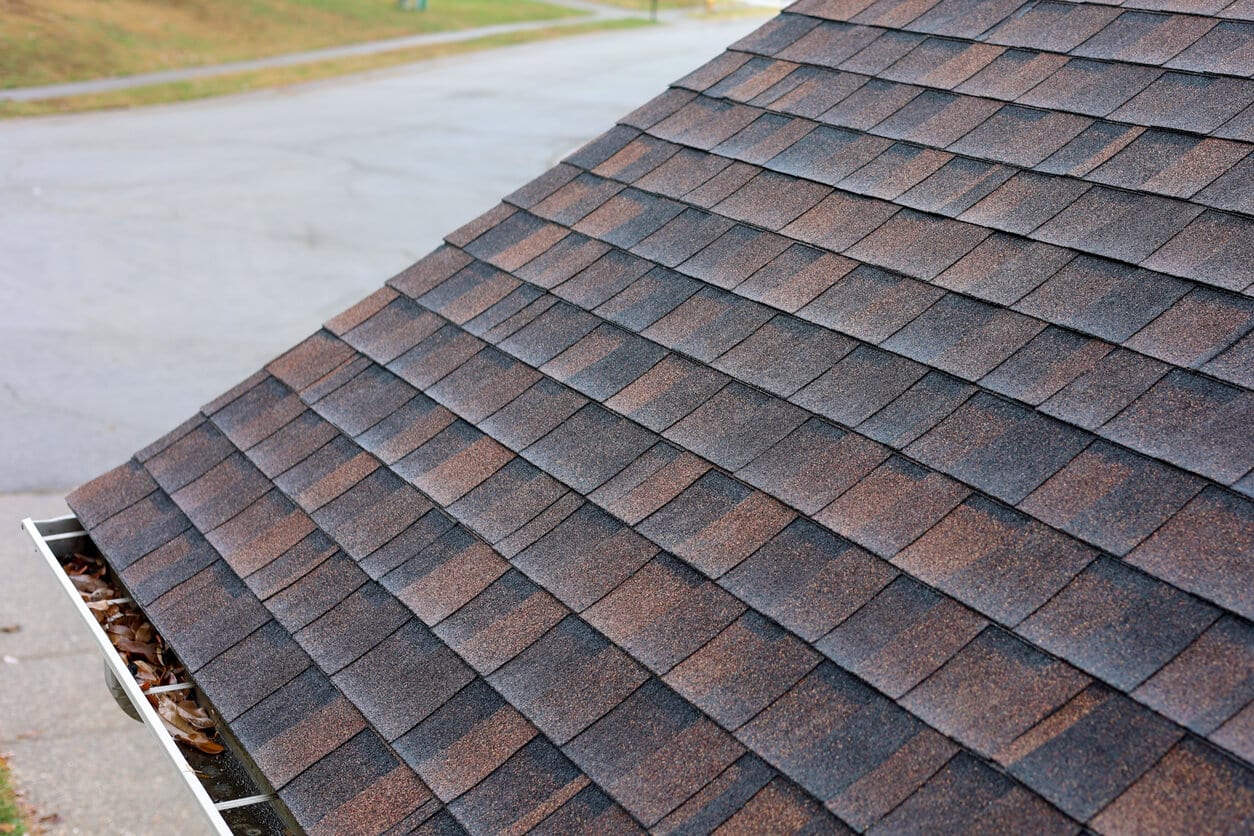
You knew it was coming. After the last storm, a few shingles ended up in the yard. There’s a faint drip in the attic after heavy rain. And every time you pull into the driveway, you can’t help but wonder how much longer your roof has left. It’s not just about replacing shingles. It’s about protecting the home where you’ve built your life. The one that holds your memories, your family, and your future.
But with so many roofing materials out there, how do you know which is best? Asphalt, slate, metal, cedar, synthetic; the options feel endless. And the stakes are high. The wrong choice can mean extra costs, added stress, or a roof that doesn’t suit your home at all.
That’s where Mr. Roofer steps in. We don’t just install roofs. We help Georgia homeowners make smart, lasting decisions with clarity and confidence. Whether you need a repair or a full replacement, our team is here to guide you through every step with honest recommendations and unmatched local expertise.
Let’s find the right roof for your home, together.
Types of Shingles: Main Categories of Roofing Shingles
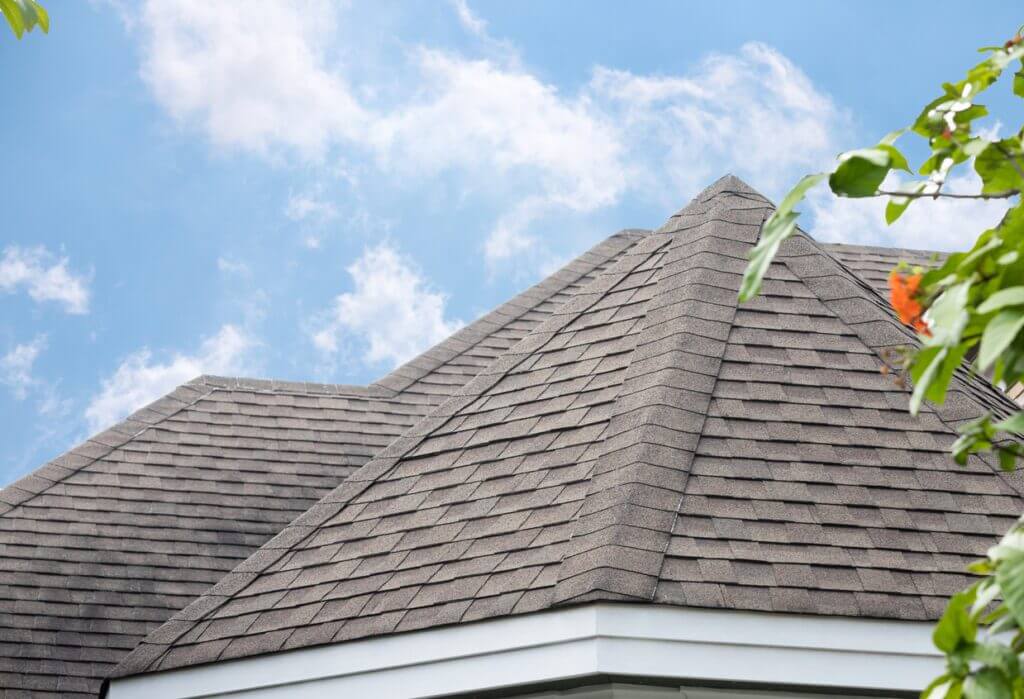
From classic asphalt to refined slate, the type of roof shingles you choose can dramatically influence your home’s durability, appearance, and long-term value. Georgia’s humid summers, heavy rainfall, and occasional hailstorms demand roofing materials that go beyond aesthetics. Each option comes with its own performance profile, making it essential to weigh both lifestyle and regional conditions when planning a roof replacement or repair.
Asphalt
Asphalt shingles are the most commonly installed roofing material in Georgia and across the U.S. Known for their affordability and relative ease of installation, they offer a range of roof shingle styles suited to both budget-conscious and design-focused homeowners.
There are three different types of asphalt shingles:
3-Tab Shingles
These are flat, uniform, and lightweight. While they come at the lowest price point, their single-layer design means they’re less durable in Georgia’s turbulent weather.
Architectural (Dimensional) Shingles
Heavier and more sculpted in appearance, these shingles use multiple layers to provide a dimensional effect that mimics wood or slate. Their thicker profile enhances durability and wind resistance.
Luxury Shingles
Luxury shingles are designed to replicate high-end materials like slate or cedar shake, offering superior aesthetics and durability. They are often used on larger, custom homes where visual appeal and longevity are key.
Here’s how the asphalt options compare:
Type | Average Lifespan | Cost per Sq Ft (Installed) | Style | Weight (per 100 sq ft) |
3-Tab | 15-20 years | $3-$5 | Flat and uniform | 150-200 lbs |
Architectural | 25-30 years | $5-$8 | Layered, dimensional look | 200-300 lbs |
Luxury | 30-50 years | $8-$12 | Mimics slate or cedar shake | 300-450 lbs |
Wood (Cedar Shake)
Cedar shake shingles are favored for their rustic charm and natural insulating properties. They offer a warm, organic aesthetic that complements craftsman-style and historic homes in older Atlanta neighborhoods. However, Georgia’s humidity can be tough on untreated wood. Without consistent maintenance and the right underlayment, cedar may be prone to:
- Rot
- Mold
- Insect activity
There are two main forms:
Hand-Split Shakes
Thicker and more rugged, these have an uneven, natural look. They are better suited for homes that want maximum visual texture.
Taper-Sawn Shakes
These are more refined and uniform in shape, offering a smoother finish while still retaining the organic character of wood.
Modern treatments and fire retardants help extend their lifespan, but homeowners should expect a higher maintenance investment compared to synthetic or metal options.
Metal (Shingle-Style)
Metal shingles combine the industrial strength of metal with the classic shape of shingles. Unlike standing seam metal roofs, these mimic the look of slate, shake, or tile while offering superior resistance to moisture, pests, and fire.
Aluminum and steel are the most commonly used materials. They are often coated with stone granules or baked-on paints to improve curb appeal and corrosion resistance.
Key advantages include high durability, energy efficiency through solar reflectance, and a lifespan that often exceeds 50 years. While metal performs exceptionally well under Georgia’s heat and storm patterns, the upfront cost can be substantial.
Composite/Synthetic
Composite/synthetic shingles are engineered from a blend of polymers, recycled plastics, and rubber, designed to mimic high-end materials like slate or cedar shake without their inherent drawbacks. They’re among the most promising options for Georgia homes thanks to their impact resistance, mold resistance, and low weight.
Popular brands manufacture them to meet Class 4 impact ratings, ideal for areas with frequent hail. They are lightweight, require little maintenance, and won’t crack or split like natural wood. Best of all, they’re often backed by 40 to 50-year warranties, making them a practical and long-lasting investment.
Design-wise, synthetic shingles can convincingly replicate luxury roofing without the cost, weight, or fragility.
Slate
Natural slate shingles are synonymous with elegance and permanence. Mined from stone quarries and cut into thin, durable tiles, slate can last well over a century if properly installed. Its deep, earthy hues and smooth textures make it a favorite for historic or European-style homes.
Slate roofs are impervious to rot, fire, and insects, and it’s exceptionally durable in the face of Georgia’s seasonal storms. That said, its weight requires a strong underlying roof structure, often making reinforcement necessary.
Additionally, slate installation demands highly skilled labor, contributing to its higher upfront cost. Repairs can be complex and costly, especially if the tiles are not locally sourced.
Clay or Concrete Tile
Clay and concrete tiles offer Mediterranean-inspired style with impressive longevity. Especially popular in Florida and the Southwest, they’re slowly gaining traction in upscale Georgia neighborhoods for their distinct look and resilience.
Clay Tile
Made from natural clay and fired at high temperatures, these tiles are durable, colorfast, and highly resistant to fire and pests. They work best in hot, dry environments, but can be used in Georgia if the home is designed to support their weight.
Concrete Tile
Heavier than clay, concrete tiles are molded and colored to resemble wood, slate, or stone. They are more affordable than natural clay and have better resistance to freeze-thaw cycles, which may be a benefit in northern parts of Georgia.
Both clay and concrete tiles require expert installation and reinforced roofing systems due to their considerable weight.
Asphalt Shingles: The King of Residential Roofing
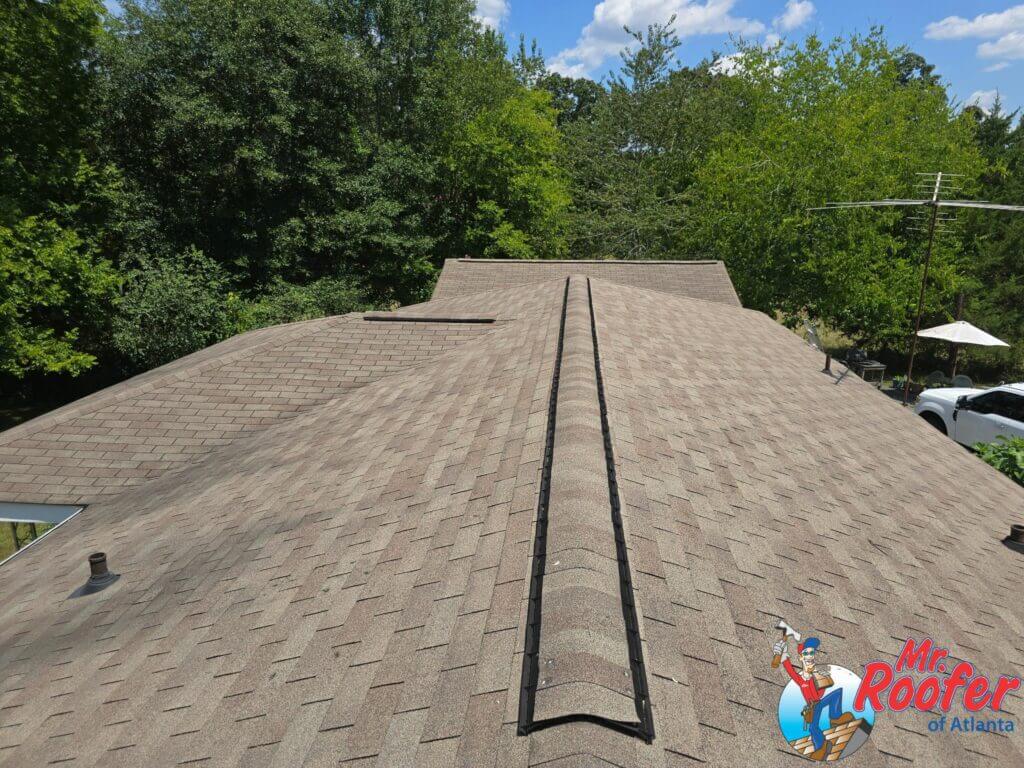
Asphalt shingles come in multiple tiers, allowing homeowners to prioritize visual appeal, longevity, or upfront savings depending on their goals. Here’s how each category stands on its own.
3-Tab Shingles
Flat profile, single-layer
3-tab shingles are made from a single layer of asphalt and fiberglass, with evenly spaced cutouts that give them their name. The result is a flat, uniform appearance that lacks the depth or variation seen in higher-end shingles. Their simplicity makes them lightweight and easier to install, but also more vulnerable to high winds and severe weather.
Budget-friendly
Of all asphalt options, 3-tab shingles offer the lowest upfront cost per square foot. They’re ideal for situations where budget is a primary concern, or when the property doesn’t demand long-term, high-end aesthetics.
15-25 year lifespan
While manufacturers often list a 25-year warranty, real-world performance in Georgia’s climate typically lands closer to 15 to 20 years, especially without regular maintenance. Wind uplift and heat degradation are common issues over time.
When they make sense (rental properties, budget-driven projects)
3-tab shingles are a logical choice for rental properties, flipped homes, or homeowners planning to sell soon. They’re functional and code-compliant, offering a quick and cost-effective solution when longevity is not the highest priority.
Architectural (Dimensional) Shingles
Dual-layer, 3D appearance
These shingles consist of two or more layers of material fused together to create a thicker, textured profile. The varied cut and layering give the roof a dynamic, three-dimensional appearance that mimics the look of natural wood shake or slate without the associated weight.
Enhanced durability (25-50 years)
Thanks to their heavier construction, architectural shingles hold up significantly better in Georgia’s wind-prone, moisture-heavy conditions. Many manufacturers back them with 30 to 50-year warranties, and they resist curling, cracking, and storm damage far better than 3-tab options.
Great for high-end curb appeal on older homes
Architectural shingles blend seamlessly with the historic aesthetic of Atlanta’s older neighborhoods. Their texture and color variations enhance character-driven homes like Tudors, Craftsman bungalows, and mid-century styles, making them a preferred choice for homeowners looking to upgrade without altering the home’s original charm.
Tie-in: Mr. Roofer recommends these for many homes in Atlanta’s historic suburbs
With decades of local experience, Mr. Roofer frequently recommends architectural shingles to homeowners in neighborhoods like:
- Decatur
- Virginia-Highland
- Druid Hills
They offer the right mix of style and staying power without requiring a structural overhaul.
Luxury or Designer Asphalt Shingles
Mimic slate or wood shake
Luxury shingles are engineered to replicate high-end natural materials like slate tiles or hand-split cedar shakes. Through advanced layering and sophisticated cuts, they deliver the elegance of a custom roof without the weight, fragility, or expense of the real thing.
Heavier, longer-lasting
These shingles are significantly thicker and more robust than standard options, which not only increases their durability but also enhances insulation and wind resistance. Properly installed, luxury shingles can last 40 to 50 years or longer, depending on ventilation and maintenance.
Higher cost but impressive aesthetic payoff
Though luxury shingles come at a premium price, the return on investment is often reflected in property value and curb appeal. They’re particularly well-suited for large custom homes, upscale renovations, or neighborhoods where visual distinction is a selling point. Their visual depth, shadow lines, and color range are unmatched in the asphalt category.
Types of Shingles: Wood Shingles and Cedar Shake
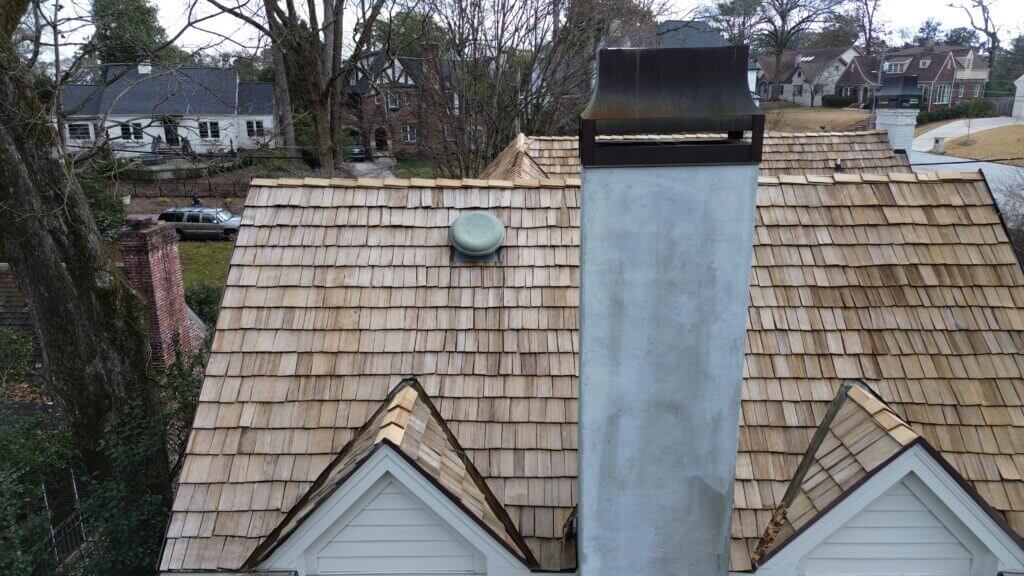
Wood roofing can be made from a variety of species, but cedar is by far the most popular thanks to its natural oils that help resist moisture and decay. It’s available in two primary forms: machine-cut shingles for a smoother, more uniform appearance, and hand-split shakes for a rugged, textured profile.
Natural, rustic appearance
Wood shingles and cedar shakes offer a timeless, organic look that stands apart from more conventional materials. With their warm tones and textured grain, they blend beautifully into wooded landscapes and lend a handcrafted elegance to residential architecture. Shake shingles, in particular, have a rougher, more irregular surface that enhances their rustic charm, while wood shingles are more uniform and refined.
Excellent for historic or traditional Southern homes
Cedar shake is a popular choice for historic restoration projects or traditional-style homes in the South. Its authentic appearance complements Colonial, Cape Cod, and Craftsman architecture. In areas like Druid Hills or Inman Park in Atlanta, where architectural heritage matters, cedar shake can preserve a home’s original character without compromising on quality.
High maintenance: susceptible to fire, rot, pests if untreated
Wood roofs demand a proactive maintenance approach. Untreated wood is vulnerable to:
- Moisture intrusion
- Rot
- Mold
- Insect damage
Additionally, in hot or storm-prone climates like Georgia’s, fire risk can be a concern unless the shingles are treated with fire retardants. Regular inspections, cleaning, and occasional repairs are necessary to preserve their integrity and visual appeal.
Lifespan: 30-50 years (treated)
When properly installed and treated, cedar shake roofs can last between 30 and 50 years. This longevity depends on local climate conditions, upkeep frequency, and whether the wood is pressure-treated or naturally rot-resistant. Treated cedar is more likely to stand up to Georgia’s humidity and seasonal storms.
Best for high-end homeowners seeking charm over cost-efficiency
Wood shingles and shakes are not the most cost-effective option, but they do offer a unique visual and historic payoff. For discerning homeowners prioritizing curb appeal and authenticity over low maintenance or modern uniformity, cedar shake provides a standout aesthetic that elevates the entire property. It’s an ideal choice for those restoring older homes or designing custom builds with architectural distinction in mind.
Types of Shingles: Metal Shingle Roofing
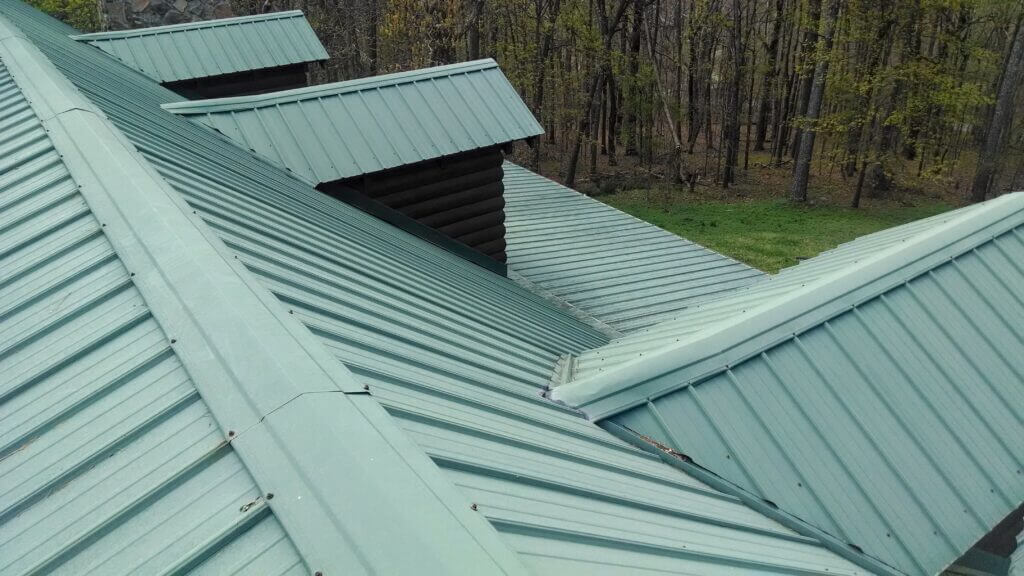
Metal shingles are a rising favorite among Georgia homeowners who want the durability of metal without the stark industrial look of standing seam roofs. These systems are crafted to resemble more traditional roofing materials, like asphalt, slate, or clay tile, while delivering:
- Superior longevity
- Heat resistance
- Minimal upkeep.
Pressed panels that mimic asphalt or tile
Metal shingles are designed to replicate the look of traditional roofing materials like asphalt, slate, or clay tile while delivering the enhanced performance of metal. These shingles are typically manufactured as interlocking pressed panels that create a sleek, uniform appearance once installed. The design options range from clean and modern to ornate and historic, allowing homeowners to maintain architectural integrity without sacrificing durability.
Durable, reflective, eco-friendly
Metal roofing is known for its exceptional resilience. It can withstand high winds, heavy rain, hail, and even wildfire embers when properly installed. The surface naturally reflects solar heat, reducing cooling costs during Georgia’s long, hot summers. Most metal shingles are also made from recycled materials and are fully recyclable at the end of their life cycle, making them a strong choice for environmentally conscious homeowners.
Great for hot climates like Georgia
The heat-reflective properties of metal shingles are particularly valuable in southern regions. By deflecting UV rays instead of absorbing them like asphalt, metal shingles help regulate attic temperatures and ease the burden on your home’s HVAC system. This thermal efficiency contributes to long-term energy savings and increased indoor comfort.
Higher up-front cost, but can last 40 to 70 years
While the initial investment in a metal shingle roof is typically higher than asphalt or wood, the lifespan more than compensates. A professionally installed metal roof can last between 40 and 70 years, with minimal maintenance and very few repairs. Over time, this reduces the total cost of ownership and makes it an attractive option for homeowners who plan to stay in their home long-term.
Available in steel, aluminum, or copper shingle styles
Homeowners can choose from a range of metals, each offering unique benefits. Steel is the most commonly used due to its strength and affordability. Aluminum is lightweight and corrosion-resistant, making it ideal for coastal or humid environments. Copper, while the most expensive, develops a striking patina over time and is often chosen for custom or luxury homes where appearance and prestige are top priorities. Each type of shingles can be finished in various colors and coatings to suit both performance needs and aesthetic preferences.
Types of Shingles: Composite and Synthetic Shingles
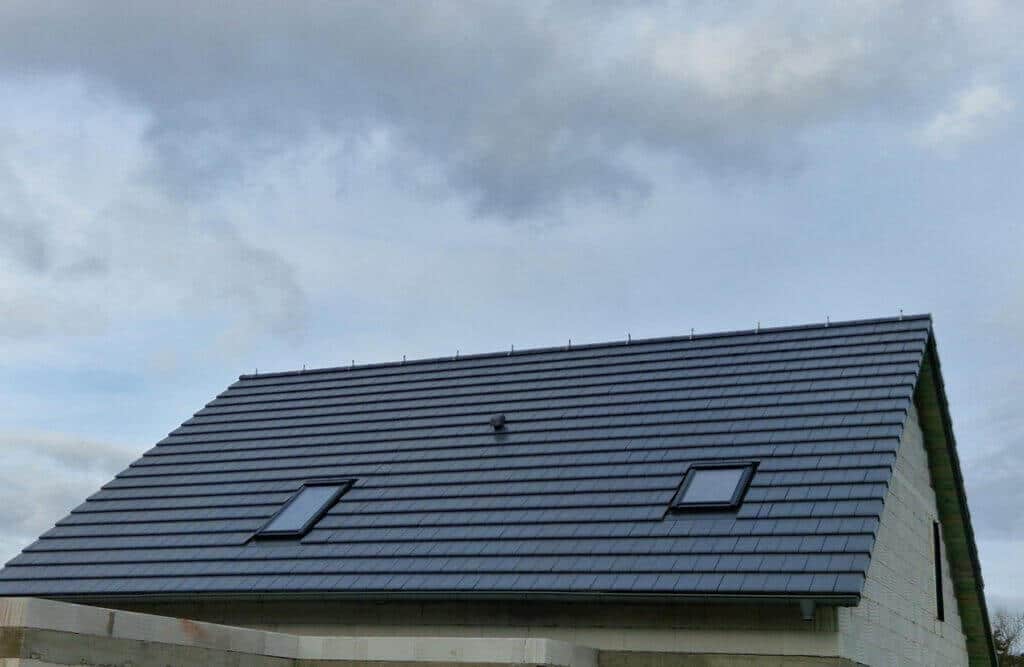
Composite and synthetic shingles have emerged as one of the most innovative roofing options available to Georgia homeowners. These shingles are designed to deliver the beauty of slate, tile, or cedar shake while addressing the shortcomings of natural materials, such as:
- Weight
- Fragility
- High maintenance.
Engineered to replicate slate, wood, or tile
Composite shingles are crafted to mimic the look of premium natural materials such as slate, cedar shake, or clay tile. Manufacturers use detailed molds to capture the texture, grain, and edges of these traditional materials, producing a remarkably realistic appearance. This gives homeowners the ability to achieve an upscale, architectural look without the weight, fragility, or cost of the original materials.
Made from polymers, rubber, or recycled materials
These shingles are constructed from advanced materials like polymer blends, rubber, plastic, or recycled composites. The result is a lightweight, impact-resistant product that offers the aesthetic value of natural roofing materials along with added resilience. Many brands also incorporate UV inhibitors and fire-retardant additives into the composition, enhancing performance in hot or storm-prone regions like Georgia.
Durable, lightweight, and low-maintenance
Composite shingles are built for longevity, often rated for 40 to 50 years or more with proper installation. Unlike wood, they do not rot, split, or attract insects. They are also far lighter than slate or tile, which reduces the structural demands on your roof deck. Homeowners appreciate the low upkeep. No sealing, staining, or special cleaning routines are typically required.
Ideal for high-end homes or replacing old cedar shake roofs
For homeowners seeking premium curb appeal without the complications of heavy or high-maintenance roofing, composite shingles offer a balanced solution. They are especially valuable in historic neighborhoods or high-end custom builds where slate or wood aesthetics are desired but not structurally or financially practical. In Atlanta, composite shingles are often used to update aging cedar shake roofs or add charm to newer luxury homes with complex rooflines.
Slate Shingles: Beauty with a Hefty Price Tag
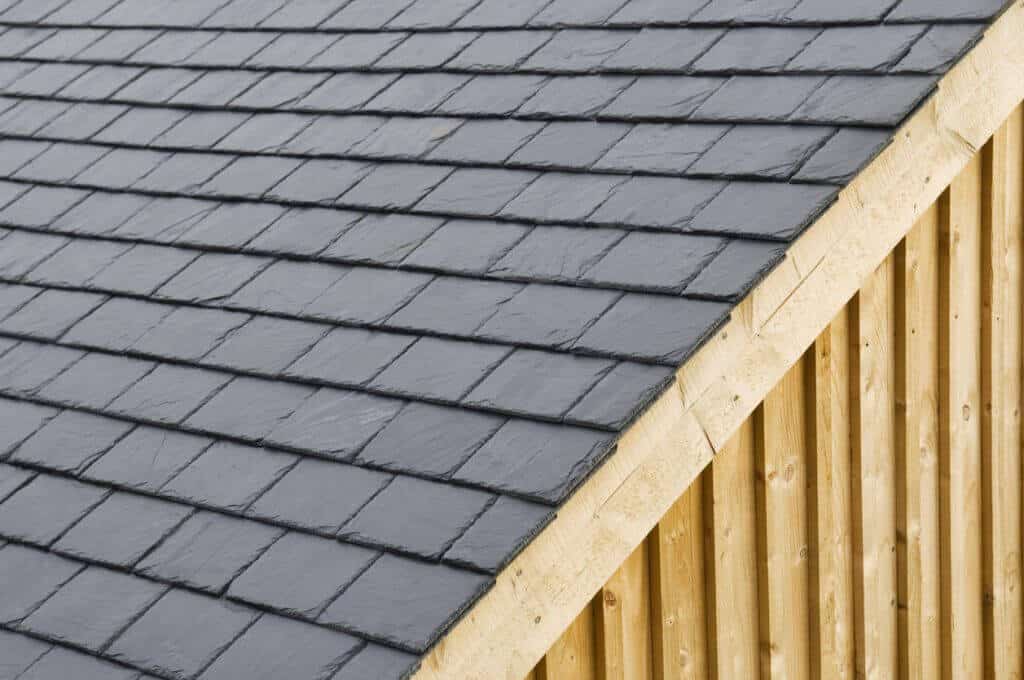
Slate roofing is one of the most visually striking and longest-lasting roofing materials available. Cut from natural stone, slate tiles have adorned historic estates and cathedrals for centuries, and their presence on a home instantly conveys timeless elegance and craftsmanship.
Natural stone offers unparalleled longevity of 75 to 100 years
Slate shingles are made from natural stone, giving them a lifespan that far exceeds most other roofing materials. When properly installed and maintained, a slate roof can last between 75 and 100 years or even longer. This longevity makes it one of the most durable roofing options available, especially appealing to homeowners planning to stay in their property long-term or preserve its legacy for future generations.
High-end appearance, fireproof, and mold-resistant
Slate’s unique texture, natural color variations, and timeless elegance make it a favorite for luxury homes and historic restorations. Beyond aesthetics, slate is also naturally fireproof and highly resistant to mold, mildew, and insects. These properties make it a sound investment in terms of both safety and long-term structural integrity, especially in humid southern climates like Georgia.
Extremely heavy and requires a reinforced roof deck
One of the primary considerations with slate roofing is its significant weight. A standard slate roof can weigh several times more than asphalt or metal shingles. Homes must be evaluated to determine if the existing structure can support the load, and in many cases, reinforcement is necessary. This can add time, labor, and cost to the project, which homeowners must factor into their decision-making.
Very expensive to install and repair
Slate is among the most expensive roofing options on the market, both in terms of material and installation. Skilled craftsmanship is essential to ensure proper installation and avoid cracked or broken tiles. Repairs can also be costly, as finding a perfect match for color and thickness requires careful sourcing. Still, for homeowners who value unmatched elegance and a century of performance, slate shingles are a worthy investment.
Types of Shingles: Clay and Concrete Tile Shingles
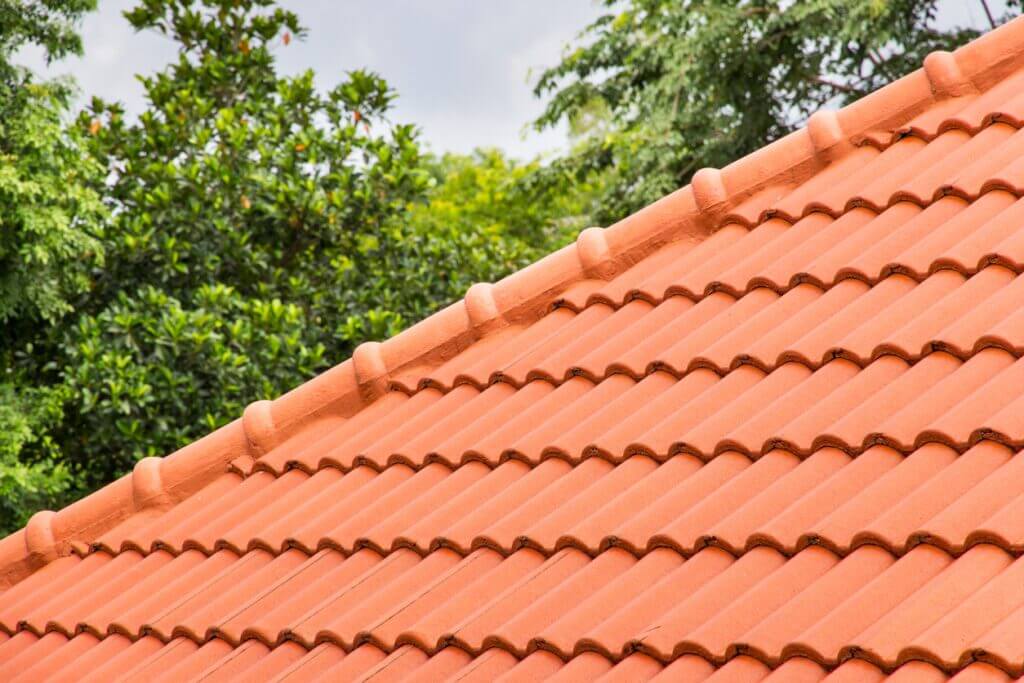
Clay and concrete tile shingles are among the oldest roofing materials still in use today, prized for their strength, thermal efficiency, and unmistakable architectural flair.
Common in Southwestern and Mediterranean-style homes
Clay and concrete tile shingles are staples of architectural styles rooted in Spanish, Mediterranean, and Southwestern design. Their distinctive curved or flat profiles lend a warm, rustic elegance to homes that embrace:
- Stucco finishes
- Archways
- Terracotta palettes
While more common in regions like Southern California or Arizona, these tiles can also add dramatic character to custom-built homes in Georgia that aim for a similar aesthetic.
Excellent durability and solar reflectivity
Both clay and concrete tiles are known for their exceptional durability, often lasting 50 years or more with minimal maintenance. They resist rot, insects, and fire, and hold up well under intense UV exposure. Their thermal mass and natural reflectivity help regulate interior temperatures, which can contribute to lower energy bills in Georgia’s hot summers. Many homeowners seeking energy efficiency appreciate these tiles for their long-term performance.
Not typically suited to most Atlanta architecture, but worth considering for custom homes
Although these roofing materials are durable and attractive, their stylistic fit does not align with the traditional brick, colonial, or craftsman homes found throughout much of Atlanta. However, they may be ideal for custom builds or luxury estates that prioritize Mediterranean aesthetics. It is important to note that clay and concrete tiles are very heavy, and like slate, require a reinforced roof structure to support their weight. For the right home, they offer a distinctive, long-lasting roofing solution that stands out in both form and function.
Types of Shingles: Comparing Roof Shingle Types by Key Factors
With so many premium roofing options available, it can be difficult to weigh the pros and cons of each. This comparison table offers a clear look at how the major types of roofing shingles stack up across key factors: lifespan, weight, visual style, cost range, and maintenance requirements.
This overview is especially useful for homeowners balancing aesthetics, durability, and long-term value while keeping Georgia’s climate and architectural norms in mind.
Shingle Type | Lifespan | Weight (per sq) | Appearance | Price Range | Maintenance |
3-Tab Asphalt | 15-25 years | 150-200 lbs | Flat, uniform profile | $3-$5 per sq ft | Low to moderate |
Architectural Asphalt | 25-50 years | 200-300 lbs | Dimensional, textured | $5-$8 per sq ft | Low |
Luxury Asphalt | 30-50 years | 300-450 lbs | Mimics slate or shake | $8-$12 per sq ft | Low to moderate |
Cedar Shake/Wood Shingles | 30-50 years (treated) | 300-400 lbs | Natural, rustic texture | $8-$14 per sq ft | High |
Metal Shingles | 40-70 years | 100-200 lbs | Mimics tile, shake, or slate | $8-$14 per sq ft | Low |
Composite/Synthetic | 40-50 years | 150-250 lbs | High-end replicas of slate or shake | $9-$15 per sq ft | Very low |
Slate | 75-100+ years | 800-1,500 lbs | Authentic stone, highly refined | $15-$30+ per sq ft | Low, but complex if needed |
Clay/Concrete Tile | 50-100 years | 900-1,200 lbs | Mediterranean, textured | $12-$25 per sq ft | Low to moderate |
Notes:
- Weight is per 100 square feet (a roofing “square”).
- Price range includes typical installation costs in Georgia but may vary based on pitch, accessibility, and roof complexity.
- Maintenance levels reflect effort, frequency, and risk factors tied to climate, pests, and aging.
Types of Shingles: How to Choose the Right Type of Roof Shingles for Your Home
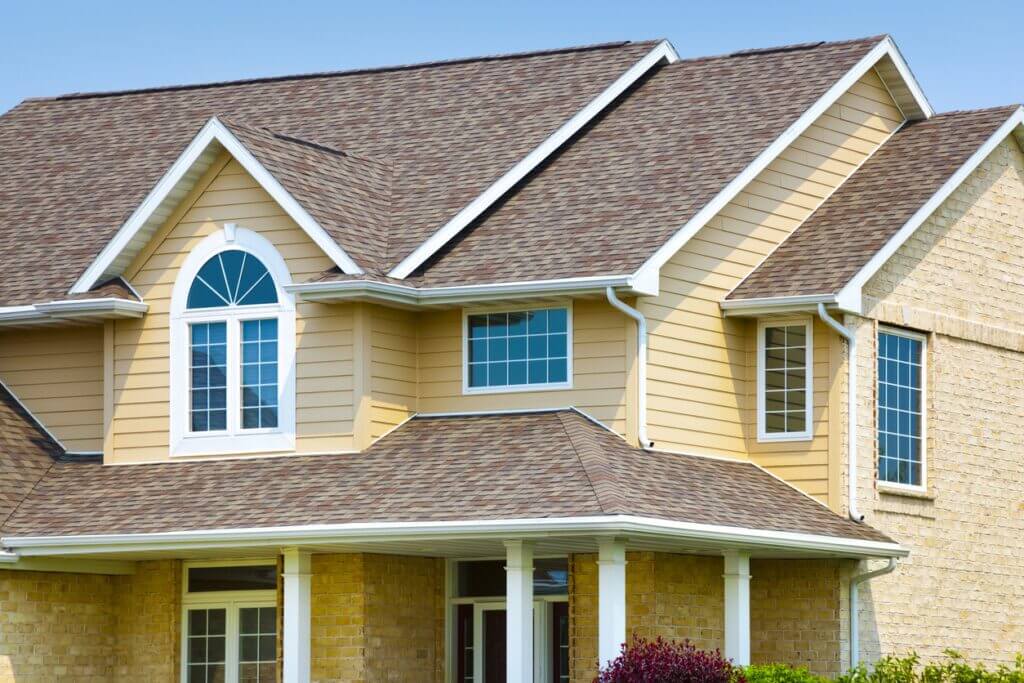
The best shingle type for your home isn’t just about aesthetics or price. It’s about finding the right match for your home’s structure, your long-term goals, and how much upkeep you’re willing to take on. Georgia’s climate, architectural diversity, and mix of new and historic homes make this decision especially nuanced.
Here’s how to think through your options more clearly.
Age of Your Home
Older homes, particularly those in Atlanta’s historic neighborhoods, often benefit from materials that maintain architectural authenticity. A 1920s bungalow in Virginia-Highland, for instance, may not be well-suited for a modern metal roof, but it might look stunning with architectural asphalt or treated cedar shake.
In addition to appearance, older homes may not have been built to handle the weight of heavy materials like slate or tile. Understanding your home’s structural integrity is the first step in narrowing your options.
Newer homes offer more flexibility, especially if the roof deck is already designed to accommodate heavier or more modern materials like metal or synthetic shingles. Builders may also leave room for design upgrades down the line.
Roof Pitch and Weight Capacity
The slope and structural strength of your roof play a major role in material compatibility. Low-pitch or flat roofs don’t shed water as efficiently, so materials like traditional wood shake or 3-tab shingles may not be ideal. In those cases, metal or synthetic options often perform better.
Weight is another factor. Slate and clay tiles are among the heaviest roofing materials available. If your home’s roof deck isn’t engineered to carry that load, installing them could lead to structural problems. Reinforcing the roof is possible, but it adds to the total cost and complexity.
Lightweight alternatives like asphalt, composite, or aluminum shingles are compatible with most existing residential roof structures in Georgia and can often be installed without major modifications.
Curb Appeal Goals
A roof accounts for nearly half of your home’s visible exterior, so choosing a material that complements your architecture is important. If you want your home to feel warm and natural, cedar shake or composite shake-style shingles offer rich texture. For a clean, dimensional look that fits both modern and traditional homes, architectural asphalt remains a safe and versatile choice.
If your goal is to make a bold statement or enhance the property’s luxury feel, slate, metal shingles, or designer asphalt can provide that upscale touch. These options often add to the resale value and help your home stand out in higher-end neighborhoods.
The roof should enhance your home’s character without overwhelming it. An ultra-modern metal roof on a classic colonial may clash, while the same roof on a minimalist new build could elevate the design.
Budget vs Longevity
While 3-tab asphalt shingles offer an affordable way to replace a roof quickly, they may not hold up well in Georgia’s climate long-term. On the other hand, investing in a 50-year metal or slate roof may reduce your lifetime roofing costs, especially if you plan to stay in your home for decades.
Luxury shingles and slate require a larger initial investment, but they can outperform and outlast lower-cost materials by decades. Homeowners who are planning for the long haul may find that higher-end materials are actually more cost-effective when viewed through the lens of time and maintenance.
It’s also worth factoring in potential insurance benefits, energy savings, and home value gains that come with longer-lasting, impact-resistant, and energy-efficient materials.
Maintenance Preferences
Every roofing material carries some maintenance responsibility. Cedar shake requires the most hands-on care, including regular cleaning, inspections for rot, and treatment for pests. Slate, though long-lasting, can be tricky to repair and should only be handled by specialists.
In contrast, metal and composite shingles are extremely low-maintenance. They don’t absorb water, are resistant to mold and mildew, and typically don’t require more than the occasional inspection and cleaning. Architectural asphalt falls somewhere in between, offering decent durability with minimal upkeep.
If you’re a hands-off homeowner or live out of town for parts of the year, it makes sense to lean toward roofing systems that require fewer check-ins and lower lifetime care costs.
Final Thoughts: Invest Wisely in a Roof That Works for You
Choosing the right shingle type is more than just picking a color or chasing a trend. It’s about protecting your home, honoring its character, and making an investment that pays off over time. Whether you’re drawn to the rustic charm of cedar, the sleek efficiency of metal, or the timeless elegance of slate, the best decision is always the one grounded in clarity and craftsmanship.
At Mr. Roofer, we’ve walked countless Georgia homeowners in Atlanta, Alpharetta, Cartersville, Buckhead and other surrounding areas through the roofing process with honesty and care. We’ll never push for a replacement when a repair will do. And when a new roof is the right move, we make sure it fits your goals, your home’s structure, and your long-term plans.
If you’re unsure where to start or which shingle fits your home best, let’s talk. Our team is ready to inspect your roof, answer your questions, and help you make a confident, informed decision. No pressure, just straight answers.
Contact us today to schedule your free quote and discover what it means to work with a roofing partner who puts your home first.
